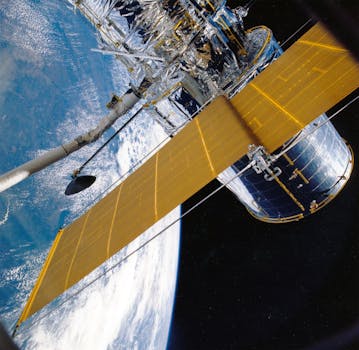
Recent advances in satellite tech are transforming the way we communicate globally, enabling faster and more reliable connections around the world. Beyond Earth, satellite technology has become a vital component of modern communication systems, providing internet access, phone services, and data transfer to remote and underserved areas. The latest developments in satellite tech have far-reaching implications for various industries, including telecommunications, navigation, and weather forecasting.
The evolution of satellite technology has been remarkable, with significant improvements in launch vehicles, satellite design, and payload capacity. The introduction of reusable launch vehicles, such as SpaceX’s Falcon 9, has reduced the cost of accessing space, making it more economical to launch satellites into orbit. This, in turn, has led to an increase in the number of satellites being launched, with many more planned for the near future. For instance, the launch of the OneWeb constellation, which aims to provide global internet coverage, has the potential to bridge the digital divide and bring connectivity to millions of people worldwide.
Advances in Satellite Design and Payload Capacity
Recent advances in satellite design and payload capacity have enabled the development of more sophisticated and efficient satellites. The use of advanced materials, such as carbon fiber and aluminum, has reduced the weight and increased the strength of satellites, allowing for more payload capacity and longer operational lifetimes. Additionally, the introduction of new propulsion systems, such as electric propulsion, has improved the maneuverability and station-keeping capabilities of satellites. The development of high-throughput satellites (HTS), which use multiple spot beams to reuse frequencies and increase capacity, has also become a key trend in the industry.
These advances have enabled the provision of higher-speed internet services, such as those offered by ViaSat and HughesNet, which are transforming the way people live, work, and communicate in remote and underserved areas. Furthermore, the increased payload capacity of modern satellites has enabled the deployment of more complex and sophisticated payloads, such as synthetic aperture radar (SAR) and hyperspectral imaging instruments, which are used for earth observation and environmental monitoring. The use of satellite-based earth observation has numerous applications, including disaster response, crop monitoring, and climate change research.
Impact on Global Communications and Navigation
The impact of recent advances in satellite tech on global communications and navigation has been significant. The increased availability of satellite-based internet services has enabled people in remote and underserved areas to access the internet, bridging the digital divide and promoting economic development. The use of satellite navigation systems, such as GPS and GLONASS, has also become ubiquitous, with millions of people relying on these systems for navigation and timing. The development of satellite-based augmentation systems (SBAS), such as WAAS and EGNOS, has improved the accuracy and reliability of navigation systems, enabling safer and more efficient transportation.
In addition, the use of satellite technology has enabled the provision of emergency communication services, such as those provided by the International Maritime Satellite Organization (IMSO) and the International Civil Aviation Organization (ICAO). These services are critical for emergency response and disaster relief efforts, providing a vital link between first responders and emergency management teams. The use of satellite technology has also enabled the development of more efficient and effective emergency response systems, such as those used for search and rescue operations.
Future Developments and Challenges
Despite the significant advances in satellite tech, there are still many challenges to be addressed. The increasing congestion of Earth’s orbit, particularly in the geostationary arc, poses a significant risk to the long-term sustainability of satellite operations. The development of new technologies, such as satellite-based solar power systems and lunar-based satellite systems, is expected to play a critical role in addressing these challenges. The use of advanced materials and propulsion systems, such as nuclear propulsion, is also being explored to improve the efficiency and sustainability of satellite operations.
The future of satellite tech is likely to be shaped by the development of new applications and services, such as satellite-based 5G networks and quantum communication systems. The use of satellite technology is also expected to play a critical role in the development of the Internet of Things (IoT), enabling the connection of billions of devices and sensors around the world. As the demand for satellite-based services continues to grow, it is essential to address the challenges posed by congestion, interference, and cybersecurity threats, ensuring the long-term sustainability and security of satellite operations.
In conclusion, recent advances in satellite tech are transforming the way we communicate globally, enabling faster and more reliable connections around the world. The impact of these advances on global communications, navigation, and earth observation has been significant, with far-reaching implications for various industries and applications. As the satellite industry continues to evolve, it is essential to address the challenges posed by congestion, interference, and cybersecurity threats, ensuring the long-term sustainability and security of satellite operations.



